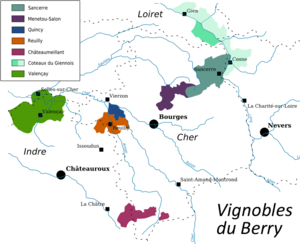Châteaumeillant (wine region)
| Châteaumeillant | |
|---|---|

|
|
| Appellation type: | AOC |
| Country: | France |
| Part of the wine-growing region: | Loire |
| Cultivation climate: | Summer mild to warm, winters colder than usual in the Loire |
| Precipitation (annual mean): | 800 mm |
| Soil types: | Sandstone, mica slate and gneiss with overlying silicates with a high proportion of sand and clay |
| Recognized cultivation area: | 550 ha |
| Planted acreage: | 20 ha (rose), 70 ha (red) |
| Grape varieties: | Gamay and Pinot Noir (red), Gamay, Pinot Noir and Pinot Gris |
| Basic yield: | 60 hl / ha |
| Wine quantity: | Red: 2800, Rosé: 1200 hl |
The Châteaumeillant wine-growing region in the two with the communes of Champillet , Feusilles , Nérot and Urciers in the Indre department and the communes of Châteaumeillant , Reigny , Saint Maur and Vesdun in the Cher . The size of the cultivation area is 250 hectares , of which 70 hectares are used for red and 20 hectares for rosé wine. It is the French wine-growing region that is closest to the geographical center of France.
history
The beginnings of vine growing are believed to be in the 5th century. The place name Châteaumeillant goes back to the Meylan of the Bituriger, a Celtic tribe, so the "Biturigan vine". In the 15./16. In the 19th century the cartographer Peutiger spoke of the place "Mediolanum", the Gallo-Roman traffic junction and an important trading place for wine amphorae. This intersection is shown on a 12th-century copy of a Roman road map stretching from the British Isles to China .
At the end of the 18th century , Gamay was introduced from Lyon , which was established from 1830. The wine-growing region has been classified as VDQS ( Vin Délimité de Qualité Supérieure ) since February 18, 1965 . In 2010 the AOC classification was added.
Natural conditions
The wine from the Châteaumeillant wine region is grown at an altitude of between 235 and 285 m. It grows on metamorphic strata of sandstone, mica schist and gneiss with overlying silicates with a high proportion of sand and clay. In the far north there are yellow limestone Hettangium (Calcaires jaune Hettangien), around Châteaumeillant also sandy deposits from the Triassic .
The foothills of the Massif Central ensure the coolest climate that prevails within the Loire cultivation area. The summers are mild and warm, the winters cool to cold. The average amount of precipitation is 800 mm, which is evenly distributed over the whole year.
Extension and expansion
The permitted grape varieties are Gamay noir à jus blanc , Pinot noir for both red and rosé wines and Pinot Gris for rosés. The planting density is at least 5500 vines per hectare, the simple guyot pruning with eight whole shoots is used. The viticulture is handled by seven private winemakers and a wine cooperative .
The harvest begins within three weeks between the last week in September and the first week in October, depending on the seasonal weather. The harvest begins with Pinot Gris, then Pinot Noir and finally Sauvignon. According to the Loire Wine Association, 80% of the harvest in Châteaumeillant is now harvested with full harvesters in order to press the harvest as quickly as possible and thus avoid unwanted oxidation . The wine only has a short shelf life of around two years.
swell
- Vins de Loire, publisher: Bureau Interprofessionnel des Vins du Center-Loire (BIVC), Tours, Sancerre, Angers 2010
- Dossier (PDF; 245 kB) from BIVC (Bureau Interprofessionnel des Vins du Center)
Individual evidence
- ^ [1] Legal text in French
- ^ BIVC (Bureau Interprofessionnel des Vins du Center): Les vins du Center Loire
